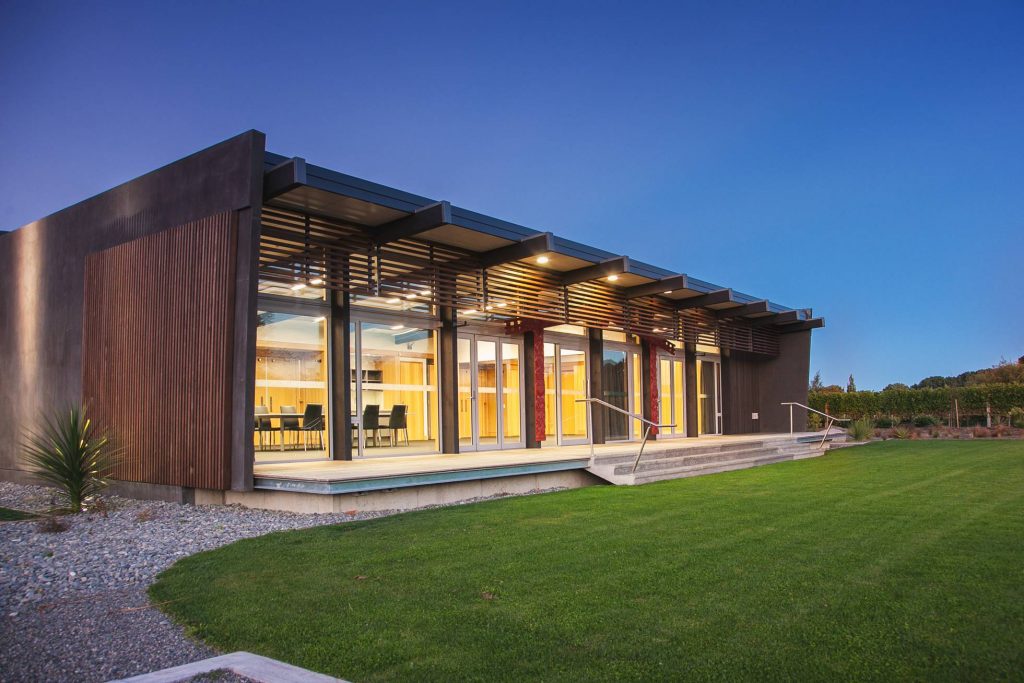BY SOPHIE PREECE
The Rangitane Cultural Centre is an architectural gem on Marlborough’s landscape, with its contemporary black cedar façade around a light-filled spacious interior. But this award winning wedding, convention and community facility is far more than a building, say those who have spent time within it.
Designed as a contemporary meeting space for the entire community, Ukaipo is named for the Māori word for nurturing, mother, or source of sustenance, and marries aspects of a traditional marae with the best of modern design, creating a space with beautiful form and superb function.
Matthew Campbell, president of the New Zealand Archaeology Association, says Ukaipo is an example of living history. The association held its annual conference at the venue this year, with 130 delegates, along with Rangitane representatives on hand to assist throughout the event, whenever required.
Matthew says as well as representing New Zealand and local history, with its displays of traditional carvings, important artefacts, and references to the repatriation of Rangitane ancestors to the Wairau Bar, the conference centre proved a modern, well set up venue with all the facilities they could require.
Ukaipo was also the perfect wedding venue for Lauren and Rik Palatchie, who held their ceremony across the wide wooden deck and sweep of lawn, surrounded by stunning native gardens. Eight men issued a wero challenge to Rik, and a karanga was issued to Lauren and answered by her cousin. “We just loved it, and so did all of our guests,” she says.
The building’s cultural link was one factor in their decision to use it, but they were also drawn by the modern lines, sunlit rooms and picturesque setting, all of which meant there was little for them to organise for a “stress free wedding,” she says. “And the size was perfect because we had over 100 people and they can cater for a lot bigger than that. And they have all the linen, all the chairs, all the tables, all the cutlery and everything you need.”
The Rangitane Cultural Centre was a winner at the Nelson/Marlborough Architecture Awards in 2013, with judges commenting that Ukaipo “exemplified the community-building role of architecture”. The architects used extensive windows and wide doors to give the building plentiful natural light, ensuring a warm and bright interior in the large central space, with capacity for up to 200 people, and in the two fully-equipped meeting rooms. The commercial kitchen was designed by two Marlborough chefs, to ensure it has everything a function might need, and works for self-catering groups and professional caterers. The bar is also set up for easy use.
Ukaipo sits upon the Grovetown site given to Rangitane by the Crown after a large tract of land was taken from the iwi under the Public Works Act in the 1950s. When its Waitangi Tribunal claim was settled in 2010, based on a vast area of land promised as reserve under the Treaty of Waitangi, but never delivered, Rangitane used the opportunity to build a facility for the entire community.
The beautiful wooden floorboards in the entranceway were reclaimed from the old Grovetown Hall formerly on the site, and are surrounded by internal glazing embossed with the signatures of every member of the tribe present for the settlement of Rangitane’s Waitangi Tribunal claim. Beyond there is an apology from the Crown, issued after the settlement, says Judith. “It is to remind us where we have been and all of those things that are important to us.”
Below the apology is a photo from the repatriation of Rangitane ancestors removed from the burial sites at the Wairau Bar in the mid-20th century and returned home over the past decade
That’s another precious aspect of New Zealand’s history and vital part of Rangitane being able to move forward, says Judith. For her the building represents a move from grievance to settlement and an evolution of the iwi’s relationships with the wider community, all of whom are welcome here. “What this place is, and the vision behind it, is that it will contribute to the social, cultural, political and economic benefits of Rangitane and the people who live within our rohe. And it has done that.”
Contact

